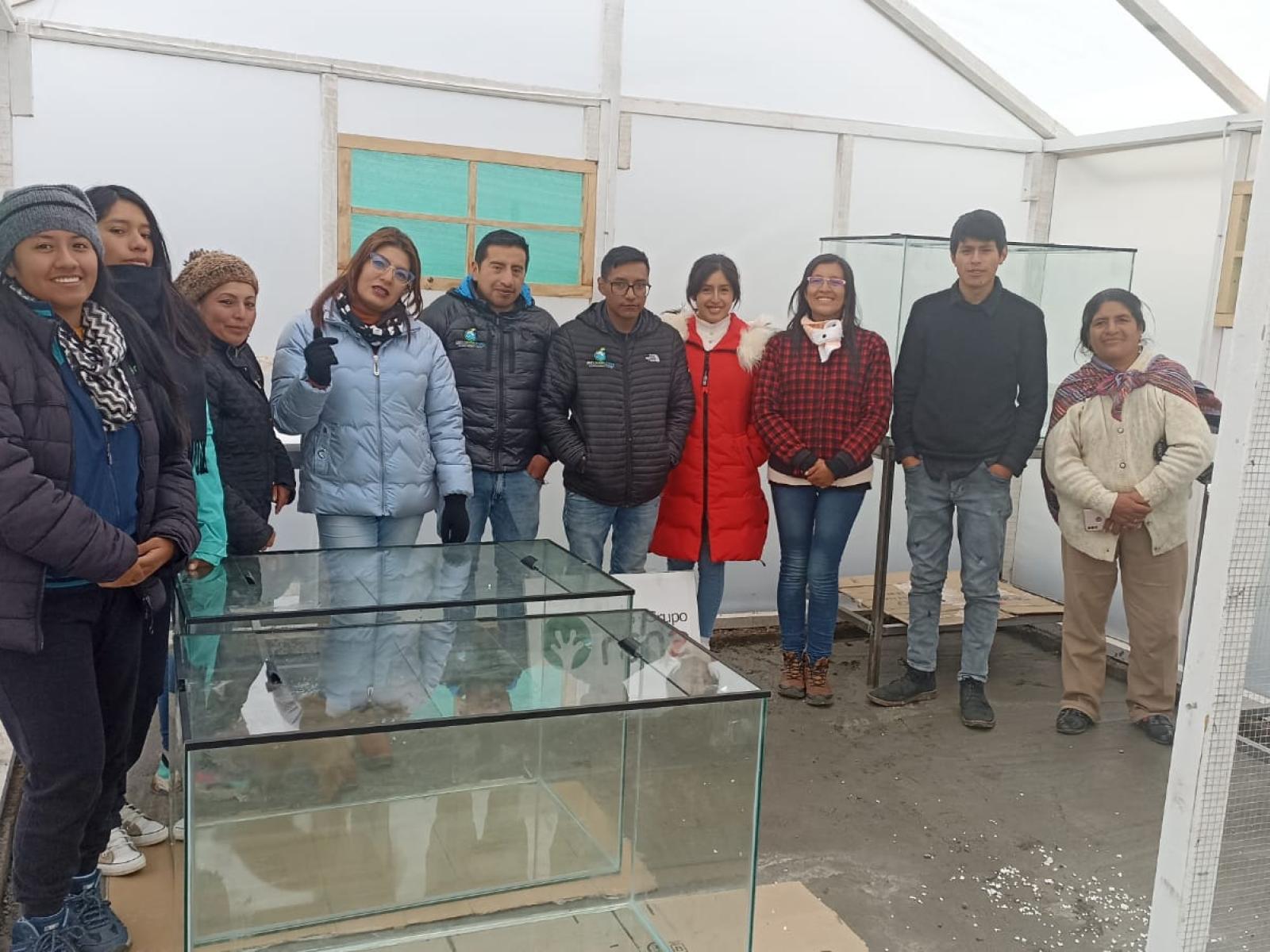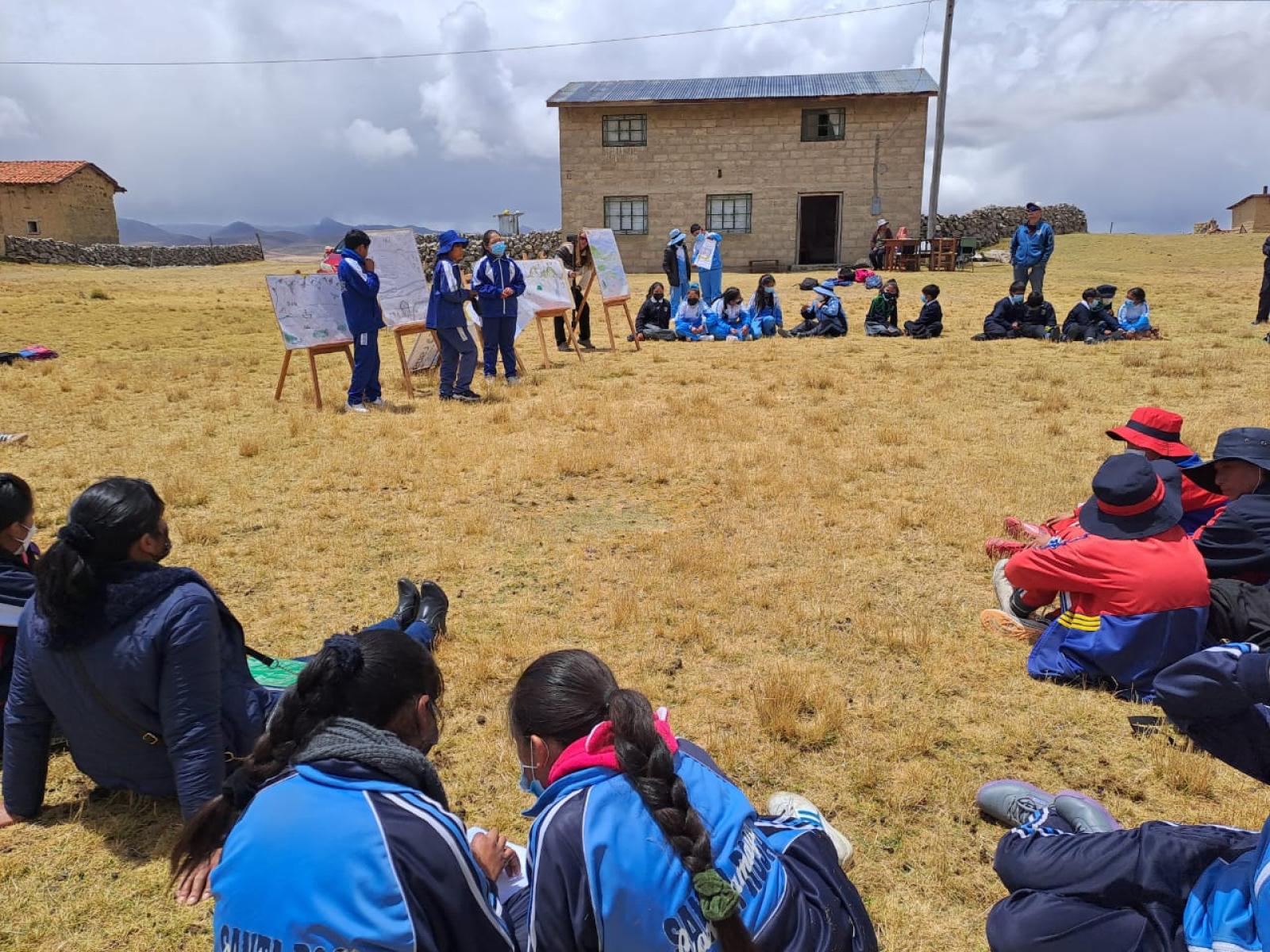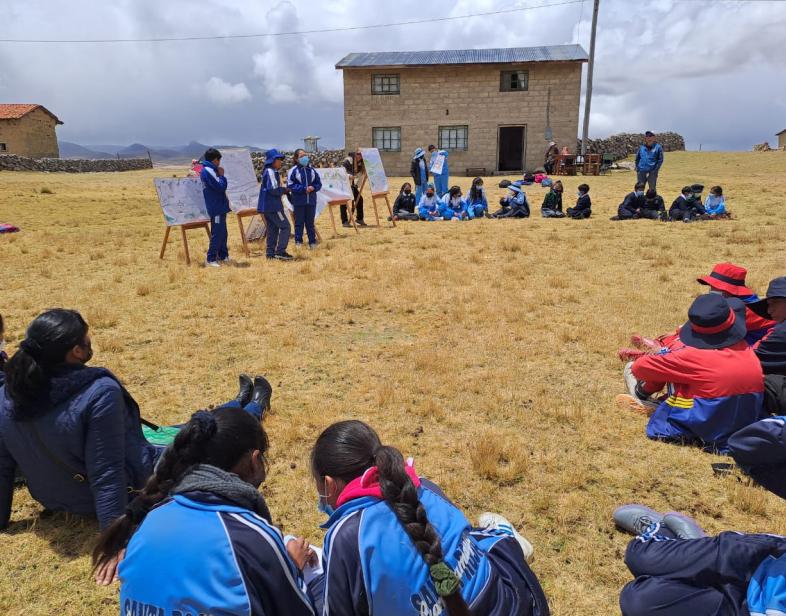An Overview Of Our Solution
We work in the sphere of influence of the Junín National Reserve, a protected natural area of Peru under two technical solutions: 1) education and dissemination on the unsustainable consumption of the Junín giant frog ( Telmatobius macrostomus ) aimed at students, teachers and communities local peasants (CC) and 2) beginning of the implementation of a breeding and conservation center for this species.
T. macrostomus is a totally aquatic endemic frog categorized as Endangered (EN) by the IUCN, it was abundant more than 30 years ago, the surrounding CCs used this species as a source of food and economic income.
Achieving that students and teachers develop scientific inquiry about the habitats of T. macrostomus , CC carry out continuous monitoring and surveillance of the species and a CC lead the creation of an ex situ conservation center
- Population Impacted: 730 people directly; 10,000 people indirectly
- Continent: South America
First name
Last name
Organization type
Email Address
Context Analysis
The giant frog of Lake Junín, Telmatobius macrostomus , a species categorized as endangered, endemic to Junín and Pasco - Peru, is characterized by being strictly aquatic and inhabits the second largest lake in Peru (Chinchaycocha), part of its geographical distribution. It includes the Junín National Reserve, a natural area protected by the Peruvian state (SERNANP), a Ramsar site, an Allice for Zero Extinction (AZE) site, and a Key Biodiversity Area (KBA). Multiple threats affect the species such as habitat alteration and loss, presence of invasive species, diseases, and overexploitation for food (Watson et al. 2017a; Castillo, 2021).
T. macrostomus was abundant more than 30 years ago, the peasant communities that lived near the rivers took advantage of this resource as a source of food and economic income through its commercialization. Unfortunately the population has decreased by more than 90% since 1997 and according to Castillo et al., (2021) the average time for it to become extinct would be 36 years. This species is important because it fulfills various ecosystem services (provision, culture and regulation).
Pilot socio-ecological studies carried out between 2018 and 2020 demonstrated remarkable ancestral knowledge about the biology of this species and interest in recovering the species. Among the information, cases of illegal collection and trafficking of frogs in local fairs were also reported. In 2022, structured interviews on illegal wildlife trafficking were conducted within the scope with emphasis on T. macrostomus , through which indications were obtained that consumption is the main cause of purchase and hunting of the giant frog.
Likewise, the actions are aligned with objective 15 of the SDGs, specifically target 15.7. Take urgent measures to end poaching and illegal trafficking of protected species of flora and fauna and address the illegal demand and supply of wild products
Describe the technical solution you wanted the target audience to adopt
To reverse the threat of unsustainable trade in Telmatobius macrostomus, we are working on two technical solutions: 1) education and dissemination of the unsustainable consumption of the Junín giant frog aimed at students, teachers and local peasant communities (CC) and 2) start of implementation of a breeding and conservation center.
Las ranas y yo, a citizen science program inserted in the local curriculum, strengthens the knowledge of students and teachers about the species, its threats and encourages their scientific inquiry.
Guardians of the Frogs involves local CCs that are in charge of carrying out continuous mitigation, monitoring and vigilance actions in areas with the presence of frogs and tadpoles and avoiding the extraction of the species and/or alteration of its habitat.
The Frog Breeding and Conservation Center makes it possible to contribute to the population growth of the species with community participation with ex situ breeding, release, monitoring and sustainable management.
Describe your behavioral intervention.
The process of involving people began in 2018 through a socio-ecological study that revealed the strong relationship that CCs have towards frogs. From this we propose the activities:
For the first solution
Present the proposal guardians of frogs to 11 CC, signing of conservation agreements, training in population and health monitoring of frogs and water quality, organization of events that promote the commercialization of their dairy products, meat, etc.
Submit a pedagogical proposal to the local Educational Management Unit on research in frog habitats, signing of an inter-institutional agreement, teachers, coordination and more than 500 students are trained in the scientific method, carry out inquiries and present results at school fairs.
For the second solution
Presentation and signing of agreements with one of the CCs that is part of the guardians of the frogs. With this, the implementation of a laboratory began to keep the frogs in captivity to repopulate the rivers with frogs within the community, and thus generate economic income through tourist visits, sale of handicrafts in the short term (2024) and use of the long term frog meat (2028).
Behavioral Levers Utilized
As needed, please explain how you utilized the lever(s) in more detail.
We provide information on knowledge, importance and national and international standards; We generate support tools such as "Me and the Frogs: Science and Citizen Empathy - Manual for Teachers" and "Frog Monitoring Guide", we enable participatory spaces for the development of scientific research, breeding center and field trips with the guide and intervention of the frog keepers and/or project team.
We encourage teachers, students and members of the CC to be key players in the prevention of illegal trafficking of this endemic species, we highlight the behavior in favor of control and surveillance when reporting possible cases of commercialization. We disseminate the actions through different platforms.
We convey the need to avoid the extinction of an emblematic species for the high Andean areas of Junín and Pasco. We provide biological information about the species that allows us to strengthen that connection.
Describe your implementation
It was essential to identify the local partners among the peasant communities, students, teachers and parents who will contribute to the development of actions. First, Grupo Rana in alliance with the UGEL Junín intervenes in educational institutions, where students and teachers strengthen their knowledge about T. macrostomus and its threats and develop research on the frog and its interaction in the habitat. As a second strategy, the peasant communities called "Guardians of the Frogs" are involved, who are in charge of carrying out continuous monitoring and surveillance in areas with the presence of frogs and tadpoles and avoiding the extraction of the species and/or alteration of its habitat. Finally, a breeding and conservation center was created in one of the communities of the guardians of the frogs to contribute to the growth of the frog population, the participation of the communities is vital, who will be in charge of caring for and intervening in the breeding. in captivity, release, monitoring and sustainable management.
All the previous actions were developed under conservation agreements and conventions, allowing the clarity of the actions and reaffirming the commitment between the parties. The link that the population has had for decades with T. macrostomus has been key to generating empathy for the species and involvement in actions in its favor.
We still cannot affirm that the solutions have been successful, but so far we have managed to get many residents to change their behavior towards frogs, for example, residents who hunted frogs are now dedicated to studying their ecosystems and monitoring their habitats, who argued that they It would make you want to eat them like they used to, but now they recognize the importance of caring for them.
At the beginning it was really difficult for the residents to trust us, but little by little they began to recognize us and began to work with us.
Describe the leadership for your solution. Who is leading the implementation?
The entire process has been led by GRUPO RANA, the Denver Zoological Foundation (DZF) and the Junín National Reserve. Among the team involved is Jhusely Navarro, 26, president of the NGO GRUPO RANA, environmental engineer, business coach, socio-environmental entrepreneur, and specialist in environmental education and sustainability. Winner of the 2020 UPC protagonists of change award. Luis Castillo Roque, 31 years old, coordinator of DZF projects in the Junín and Pasco regions, biologist, with master's studies in biodiversity and ecosystem management, winner of the Carlos Ponce del Prado 2021 award, specialist in threatened high Andean amphibians, with experience in ecology, planning for the conservation of species. Milagros Rojas, 26 years old, project manager, environmental engineering. Together with them a young team of more than 30 people including coordinators, collaborators and volunteers from environmental engineering, biology, social communication, graphic design, among others.
Share some of the key partners or stakeholders engaged in your solution development and implementation.
Our work has been designed under a co-leadership between the Junín National Reserve, a protected natural area in charge of protecting the flora and fauna, and scenic beauty of Lake Junín, and the Denver Zoological Foundation.
The peasant communities, UGEL, educational institutions, teachers and students are our local partners since they are the ones who use the natural resource.
The different actions have been possible thanks to the financing of National Geographic, The Rufford Foundation, New England Biolabs Foundation, Amphibian Ark and Mohamed Bin Zayed, as well as local companies such as ElectroPerú.
Who adopted the desired behavior(s) and to what degree? Include an explanation of how you measured a change in behavior.
The change has not yet been strictly measured, however some of the indicators are presented here:
- 47 Frog Guardians managed to sign conservation agreements, designate a frog habitat protection area, conduct annual monitoring of the frog population. They deploy community surveillance actions and report possible cases of commercialization of frogs.
- 631 students have been part of learning sessions where they have been informed about T. macrostomus and its threats, developing collaborative scientific inquiries presented at school science and technology fairs.
- 1 conservation and breeding center has been implemented under the leadership of a peasant community to keep the frogs in captivity to repopulate the rivers within the community, and thus generate economic income through tourist visits, sale of handicrafts in the short term ( 2024) and long-term use of frog meat (2028).
How did you impact the environment (biodiversity conservation, ecosystems, etc.)? Please be specific and include measurement methodology where relevant.
No direct impacts were obtained, but there were more than 700 people among frog guardians (CC members), students, teachers and parents who were sensitized to the importance of protecting frogs and their aquatic habitat.
The students' investigations were related to the evaluation of water quality with benthic macroinvertebrates and physicochemical parameters, reporting their findings in scientific notes.
How has your solution impacted equity challenges (including race, ethnicity, social class/income, indigenous communities, or others)?
The solutions are aimed at gender, race and social class equally between students, teachers and guardians of the frogs.
What were some social and/or community co-benefits?
Among the benefits granted is the delivery of materials and equipment for monitoring and surveillance of frogs, training related to their main economic activities. Students and teachers were accompanied in the learning process and development of collaborative scientific research. The community where the frog breeding and conservation center is being installed is covering all the costs of implementing the laboratory.
What were some sustainable development co-benefits?
Adopt urgent and significant measures to reduce the degradation of natural habitats, stop the loss of biological diversity, likewise contributed to the education of more than 600 young students, efforts were consolidated to implement a breeding and conservation center.
Sustainability: Describe the economic sustainability of your solution.
Yes, currently the initiative requires external financing and has not yet achieved economic sustainability since it is a long-term project. The goal is to achieve government subsidies by competent entities on the issues of illegal trafficking framed in the National Strategy. In the future, it is expected to demonstrate alternative sustainable solutions such as the breeding and conservation center that will allow income for tourism and research.
Return on investment: How much did it cost to implement these activities? How do your results above compare to this investment?
More than 600 students and 20 teachers trained, in an investment of $9,000 per year.
47 guardians of the frogs carry out monitoring and surveillance $10,000 annually
Beginning of the implementation of the breeding center $5000
The results definitely exceed the investment, since the trust and involvement of the local population in our activities has been achieved.
How could we successfully replicate this solution in Latin America?
We are not aware of technical solutions similar to those we propose; however, we believe that it is entirely possible to develop this type of solution by making the corresponding adjustments, adaptations, and contextualizations. We start from the history of T. macrostomus , and its link with the population, we carry out surveys and interviews to learn more about this situation, then we focus on working subgroups (educational institutions) and communities.
We developed strategies and actions based on the needs of each subgroup, empathizing with them, the different actions carried out were jointly planned and implemented and in this way we achieved identity and appropriation of the frogs and I, the breeding and conservation center and guardians of the Frogs.
We have been working since 2018 and each year the investment to carry out these solutions increases, only in 2022 $24,000
We also recognize that our solution still could not be classified as 100% exi


